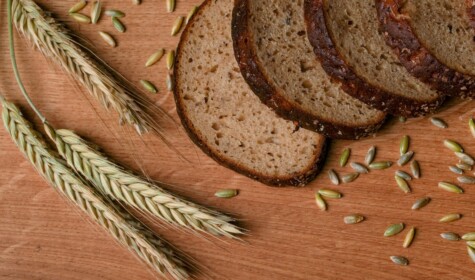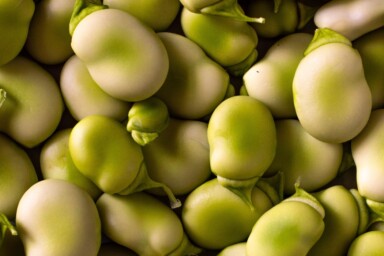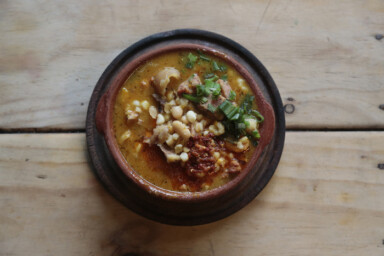The importance of bread in the UK is revealed in our everyday language. From the church, ‘give us our daily bread’; to social relations, ‘bread winner’; from economics, ‘below the breadline’; to innovation, ‘best thing since sliced bread’. Bread is ingrained in our society.
Yet, despite being at the heart of our culture and diets, most bread falls alarmingly short of the mark when it comes to sustainability. In fact, modern-day bread is failing us on many levels – socially, economically, nutritionally – with the problems including, but certainly not limited to, farming methods.
To improve the sustainability of bread, we need to understand what ‘state of the art’ bread production looks like, from seed to shelf. In the UK, wheat is generally produced from high-yielding monocultures grown using artificial fertilisers and herbicides, a model that tends to be economically viable only through the help of subsidies. Traditional organic wheat production, whilst more environmentally friendly due to the absence of inorganic chemicals, relies on crop rotation in which wheat is generally only planted once in every five rotations, thus requiring considerably more land than a monocultural system. By current estimations, the organic wheat grown in the UK per year is less than what would feed the population for one week.
Wheat production also falls victim to extreme weather events which are taking place more frequently due to climate change. During the 2018 heatwave, there was an 84% reduction in the export value of UK wheat due to yield losses caused by the drought. This demonstrates the need for innovative methods of wheat production that minimally contribute to greenhouse gas emissions, make efficient use of limited agricultural land and mitigate the threat of food insecurity.
For decades, scientists have responded to the challenge of maintaining agricultural productivity by selectively breeding wheat crops with characteristics that arm them against the threats of climate change, for example, drought resistant varieties. But, in doing so, the pool of genetic diversity is being drained in such a way that there will be little variation to draw upon in the future. In Ireland, the vulnerability caused by a lack of diversity in the potato crop over 173 years ago has shaped the country’s social, demographic and economic history. The repercussions of the famine are still felt by contemporary Irish populations several generations removed from the actual event, demonstrating the long-term ramifications of a lack of genetic diversity.
Homogeneity is an unwise policy, which is especially unsustainable considering the need to equip the agricultural sector with the resilience and diversity to withstand and adapt to the stresses posed by climate change. The issues surrounding the current production of wheat can be briefly summed up in one word: ‘uniformity’. Thus, from the antonym of this word emerges the solution for the sustainable production of wheat: ‘diversity’ – both within fields and between farms.
Diversity within fields
Genetic diversity within fields can be achieved in a productive wheat system by using composite cross populations. Martin Wolfe of Wakelyns worked with the Organic Research Centre to pioneer this new breeding method for suitability to low input organic wheat systems by selecting 20 varieties of wheat with a proven record in these systems. Half were selected for their yield (Y) and the other half were selected for their nutritional quality (Q). A composite cross population was created by breeding every possible combination, resulting in 190 new crosses. The high diversity of plants in the population means that the plants complement each other in their characteristics and make the best use of resource niches to compensate for each other in the event of failures or weaknesses.
Composite cross populations can also adapt to local pressures by natural selection, enhancing the population’s adaptation to environmental challenges over time. While the yield may not be as great as a high yielding monoculture, for many, the resilience of composite cross populations achieved through diversity outweighs this potential drawback.
Diversity between farms
There is likely to be no silver bullet for the development of sustainable farming methods for wheat; rather, sustainable production will be achieved by selecting the most appropriate methods for each farm’s individual characteristics, generating diversity in farming practices between farms. In the sustainable production of wheat, although different methods may be used, some over-arching principles should be applied; these include minimal input systems, a focus on soil health and the integration of livestock for nutrient recycling where appropriate. Even before specific farming methods are considered, the adoption of these principles will require a paradigm shift away from the conventional high input systems that dominate cereal production in the UK, so it is imperative that sustainable wheat farming is supported through policy.
The sustainability of certain farming methods can be assessed through an evaluation of the ecosystem services which they offer – in other words, the benefits to humans that are provided by a healthy environment. Agroforestry and intercropping offer two viable options for the sustainable production of wheat in a variety of farm contexts. Agroforestry, a farming practice that combines trees and shrubs with crop or livestock systems, offers benefits to humans through carbon sequestration, biodiversity conservation, soil enrichment and air and water quality, not to mention that incorporating trees into arable farms also expands the income generating opportunities for farmers, creating markets for fruit and wood-chip production, and stimulating agritourism.
Intercropping, which involves growing two or more crops in close proximity, is another way to improve the sustainability of wheat production. Not only can intercropping reduce the incidence of crop disease, improve soil fertility and enhance weed and insect control, experimental studies show that nitrogen fertiliser inputs can be reduced by half when intercropping wheat with grain legumes (e.g. beans, lentils, peas) – an attractive proposition for more sustainable wheat production.
An innovative take on intercropping has been developed by UK based company, Wildfarmed. Their method involves planting wheat in a strip-till system within a permanent herbal ley. This method minimises soil disturbance by localising it to the wheat strips only, whilst the herbal ley conserves soil health and maintains in-field biodiversity. The permanent herbal ley provides the additional benefit of supplying nutritious grazing for livestock, who return essential organic nutrients to the soil to build fertility. Wildfarmed estimates that their farming technique could build organic matter at a rate of 0.1-0.2% every year, sequestering carbon from the atmosphere and mitigating global warming.
Land-use change requirements
We know that conventional agriculture is environmentally unsustainable, and that the industry requires a shift to greener alternatives. A common argument against the adoption of more environmentally friendly farming methods, is that it could result in a reduction of yields, prompting the question: is there enough land in the UK to produce enough food in an environmentally friendly way?
There are two schools of thought as to how to deliver the best outcomes for nature on an island of limited land resources. Some favour the land-sharing model, where agroecological farming is designed to co-exist with nature. Others insist that to maintain food security, we need to invest in emerging technologies to ‘sustainably intensify’ agriculture, freeing up farmland for ‘rewilding’, in other words, land-sparing. Research in the National Food Strategy instead suggests that a ‘Three-Compartment Model’, where high yielding farmland is incorporated with low yielding farmland and semi-natural land, outperforms the alternatives of strict land-sparing or land-sharing on measures of biodiversity, while still maintaining the target for food production – yet another instance where diversity is key.
Whichever vision for the future of farming is favoured, the question of dietary change will be key. If we keep eating as unhealthily, excessively and wastefully as we do today, then there’s no doubt that a significant proportion of the UK’s farmland will need to be farmed intensively. If, however, we shift to healthier and more sustainable diets, with a reduction in intensively produced livestock products a key part of this, then there will be much more space for the lower-yielding but more nature-friendly farming practices that are needed to regenerate our increasingly degraded farmland soils. In fact, as the Feeding Britain report, and similar modelling by the FFCC, has shown, dietary change in line with sustainable farming, would allow all of the UK’s farmland to be managed agroecologically (with significant areas freed up for woodland creation and nature) without any need for more food imports.
The social justice of sustainable wheat
If the queue outside Jolene bakeries throughout North and East London on a Saturday morning is anything to go by, there is a market for good quality bread made from sustainably farmed wheat. However, at a price of around five quid a loaf, we must consider that this sort of bread, with the nutritional and environmental benefits that it offers, is a luxury only afforded to some.
The reality is that this is the real price of making food in an environmentally friendly way. Food that is cheap is probably so because the price excludes the externalities, such as the costs to our health service and our environment. Recent studies have shown that factoring in the externalities into the price of food in the form of a tax would double the cost of the weekly shop. This is clearly an inequitable and blunt means of encouraging sustainable production, with the economic impact of protecting the environment falling hardest on the least affluent. This introduces a social justice component to the sustainable production of bread and highlights the need for the creation of sustainable markets which reward farmers for the quality of the grain, the soil and ecosystem, whilst also ensuring equitable access.
The solution lies in a policy portfolio of incentives and restraints that help to shift the food system to more sustainable practices. The new ELMs policies aim to do just this; it remains to be seen if they can deliver.







